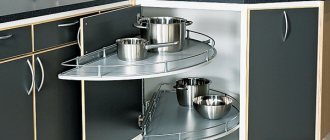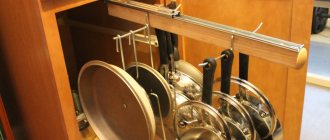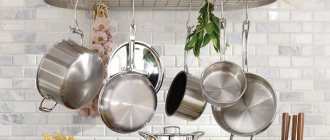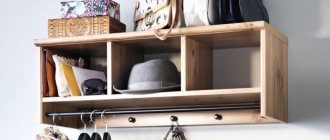Owners of small apartments often face a lack of space. This problem is especially acute in the kitchen. For example, how to store pot lids? After all, due to their non-standard shape, they take up too much free space. Below are the most successful solutions. The list includes both store-bought devices and those that you can make yourself.
Drainer
You can compactly store pot lids in the kitchen in a drying rack located inside a wall cabinet. Its advantage is that all the dishes are in one place and hidden from view, and the decor looks neater and more laconic. Usually a dish dryer comes with a kitchen unit. If there is not enough space in it, you can remove extra plates that are rarely used.
Organizers
Factory organizers are designed to be installed on a countertop or inside a drawer. They divide the free space into several compartments, allowing you to conveniently arrange all the dishes.
The problem with organizers is that it is not always possible to choose the right size model. In this case, the space can be filled with several containers made of plastic or metal. In such a separate box you can fold the lids compactly. So that they do not fall and take up unnecessary space in the closet.
Another option for zoning space: non-standard use of lid stands from the mass market.
Usually these structures are collapsible. However, many manufacturers produce models with adjustable sizes. This stand can be transformed into a vertical partition for a drawer. This method is ideal for those who live in a rented apartment. After all, it does not require drilling walls or furniture.
In principle, you can make a partition yourself, for example, from wood or plywood. But in this case you will have to spend more effort and time.
Table stand
An excellent accessory that is convenient to use while cooking. Condensation from the pan lid will flow onto the stand, and hot elements will not damage the countertop. You can also place a spoon or ladle on it. But this is rather an intermediate option - when the lid is removed from the pan, it needs to be put somewhere. For permanent storage in the kitchen, such a stand will not be convenient.
Rack for kitchen utensils
If there is free space on the countertop, it is convenient to store pot lids on a special stand with dividers. The stand combines the function of a dryer and can be made of metal, bamboo or plastic. It can be hidden in a wall cabinet or bedside table. There are many different types of storage racks. You can find a suitable option for both a small kitchen set and a large kitchen.
Storage for pot lids
This option is suitable for those who are at the renovation stage and are just planning to update their kitchen.
When ordering a kitchen set, you can initially take care of a separate storage compartment. The most common options:
- narrow drawer , which is usually located directly under the tabletop. Each such storage can accommodate 3–5 units (depending on the diameter). If necessary, this section can be repurposed at any time for cutlery or cutting boards;
- cargo - a similar narrow drawer, but vertical. They can fill the free space in the corner of the room or in “inconvenient” places: under the windowsill, near the radiator, etc. This option is also suitable for storing small jars, such as spices.
- wall shelf for lids . This solution is suitable for those who do not plan to change their kitchen set. This piece of furniture can be hung separately or as a continuation of wall cabinets.
You can also find ready-made shelves on sale; they are suitable for storing not only lids, but also baking trays, trays or cutting boards.
Wall holder
A common method for storing pot lids vertically in the kitchen is a metal frame structure with several crossbars. The holder can be mounted on the wall near the sink, stove, on the apron, or fixed on the door or side wall of the cabinet. The height of the device depends on the number of covers. The advantage of a hanging stand is that it saves space in cabinets. Disadvantages include dust settling and visual clutter in the kitchen. When placing the holder on cabinet doors, the shelves should be slightly narrower than standard so as not to interfere with the closing of the doors.
Pendants
Unlike holders, there are many pendants on sale. The most common forms:
- hanging racks for lids;
- staples;
- rails (they can be replaced with towel racks or long furniture handles);
- supports. Nails or self-tapping screws with curly heads are suitable for these purposes. With their help, you can attach the covers to the door, as shown in the photo below.
In addition, hooks are used, but only a few for each piece of utensil.
Place lid hangers on any available vertical surface:
- on the doors of kitchen cabinets (outside and inside);
- on the side walls of furniture;
- on the kitchen walls.
There are few disadvantages to pendants:
- when installed outside, dust and grease settle on the utensils;
- when placed on doors, they create additional load on the hinges. Inexpensive chipboard sets can quickly become unusable.
But with the right choice of location, using such devices is quite convenient.
Drawer
One of the convenient ways to store pot lids in the kitchen is a separate drawer, which is often used as a tray for cutlery. When ordering a headset, you can provide several similar compartments.
Ovens are most often installed at some distance from the floor, so a basement drawer can be built under the hob to store kitchen lids.
Compartment in the cabinet drawer
If you are the owner of wide and deep kitchen cabinets, then the question of how to place the lids can be solved without difficulty. A spacious compartment should be provided inside the roll-out box, which will allow you to ergonomically organize its filling. Compartments can be built-in or purchased separately.
Door mounts
This method is only suitable for storing lightweight pot lids and durable doors. It saves space in the closet because it does not take up interior space. The device is fixed with adhesive tape. To secure, you can also use hooks, which are sold in construction and hardware stores. If the cabinet door does not allow this, use the front part of the kitchen facade for storage.
A more convenient form of holder for storing pot lids consists of two parts, since they can be installed at any distance. The device is made of durable plastic and is fixed to the wall with adhesive tape.
Fixation with hooks
Advantages and disadvantages
Order on the work surface and inside the cabinets ensures the correct placement of dishes. Storing pots and pans with lids has its supporters. This method provides a certain convenience in using utensils, but the free arrangement of closed dishes will occupy all the cabinets, even in a spacious kitchen. Cluttering the shelves doesn't look very attractive, and it's unlikely that you'll be able to get the pan out silently. Most housewives choose to store lids and dishes separately, which is practical and advisable. Each option has advantages and disadvantages. The second one is easier to optimize with the help of special stands.
Modern devices help to rationally distribute utensils and avoid stacking lids in a small kitchen. The housewife will not have to waste time choosing the appropriate element. In such a process, it is difficult to avoid the noise created by falling or touching covers. Stands of various shapes, textures, and styles add order to the space. From a variety of models, you can always choose the optimal design for any kitchen.
Most stands are inconvenient for storing different-sized lids. If structures are made of metal, they are susceptible to corrosion.
Railings
In addition to pot lids, you can hang everything for cooking on the rails - this way the worktop will not be occupied, and everything you need will be at hand. The surface underneath must be resistant to mechanical damage and easy to clean. Small rails can be attached to the inside of cabinet doors. Instead, rods are sometimes used to dry towels.
Pot lids that do not spoil the attractiveness of the kitchen - steel or glass - are stored openly. They blend into the surrounding environment, do not attract attention and do not clutter up the space. You can attach a hanging rack to the railing, which has special clamps.
Hanging holder
A clever way to store lids is to string them onto the handles of saucepans and frying pans and hang them on special hooks. It’s convenient that everything is sorted immediately and does not require time to search and select a set. The method is suitable for those who cook a lot and have a whole collection of pots, ladles and other utensils.
DIY string holder
A simple way to store pot lids in the kitchen to make with your own hands - you need to measure the diameter and fasten several strings or pieces of copper wire of a suitable length to two self-tapping screws inside the cabinet. They should sag a little so that the weight is distributed evenly along the entire length and ensures reliable fastening.
Instead of a string, you can stretch a rubber band that stretches and can support a pan lid of any size. When installing rails or strings, you need to take into account that the protruding handle does not interfere with closing the door. It should be located at the same level as the internal shelf.
Materials
Lid stands for modern pots are made from materials whose texture and quality vary significantly. Models available:
- Made of wood - suitable only for dry, clean dishes. They look noble, expensive, and decorate the kitchen.
- Made of glass - they are rare, they fit perfectly into the interior of any style.
- Made of metal - suitable for both dry and wet dishes, practical, reliable in use. They require periodic cleaning and drying. Stainless steel retains its attractive appearance for a long time; rust may appear on structures made of other alloys when exposed to high humidity.
- Made of plastic - they decorate the interior with rich colors and fancy shapes. They do not last long due to rapid mechanical wear.
Models of any design require regular care. Stands, except for wooden organizers, should be periodically washed, deposits removed, wiped dry, and kept clean.
Wooden
Metal
Plastic











